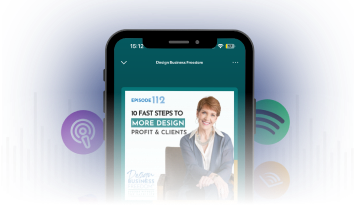Charge Your Worth in Interior Design
If you’ve ever struggled with feeling undervalued in your creative work, it’s time to explore a different approach to pricing. Let’s dive into the crucial difference between charging based on your time and charging based on the true value you deliver to your clients through charging your interior design value.
Understanding the Three Universal Problems
Every creative project you take on addresses one or more of these universal problems: health, wealth, and relationships. Let’s break it down.
Health: This isn’t just about physical health but also mental, emotional, and even spiritual well-being. Your work as a designer directly impacts your client’s overall sense of well-being.
Wealth: Wealth isn’t only about money; it’s also about status. Your designs can elevate a client’s status and increase the value of their home or business, making your work a significant investment.
Relationships: Your designs affect your client’s relationships, whether with family, friends, or business associates. Creating spaces that foster connection is a powerful outcome of your work.
Recognizing which of these problems your work solves allows you to better communicate your value to clients, making it easier to justify your fees through charging your interior design value.
The Pitfalls of Hourly Rates
Charging by the hour can trap you in a cycle of undervaluation. Here’s why it’s time to consider a new strategy.
It Ignores the True Value: Hourly rates don’t capture the years of experience, creativity, and unique solutions you bring to the table. You’re not just selling time; you’re selling transformative results. This is a key reason to shift to charging your interior design value.
It Penalizes Efficiency: If you’re a quick worker, charging by the hour means you earn less. Your speed and efficiency should be an asset, not a drawback.
Tracking Time is Stressful: Constantly tracking and justifying your hours is burdensome. By switching to value-based fees or packages, you free up time and mental energy to focus on what you do best—creating. Charging your interior design value helps you avoid the stress and inefficiencies associated with hourly billing.
These are key considerations in developing effective charging your interior design value strategies.
Switching to Charging Your Interior Design Value

Making the shift from hourly rates to value-based fees is essential for designers. Here’s how you can make that transition.
Calculate Fees Based on Value: Consider the scope of work, complexity, and long-term ROI for the client. For instance, a kitchen remodel isn’t just a one-time project; it’s a transformation that impacts the client’s daily life for years. This approach aligns with the principles of charging your interior design value.
Use a Minimum Fee: Establish a minimum design fee that reflects the value of your work. This ensures you’re compensated fairly, even for smaller projects, and is a cornerstone of charging your interior design value.
Introduce a Refresh Fee: For long-term clients, offer a refresh service. This could involve updating a room’s design after a few years to keep it current and stylish, providing an opportunity for repeat business. This strategy fits perfectly within the charging your interior design value framework.
It’s About the Investment, Not the Budget
Words matter. When discussing fees, frame the conversation around the concept of an investment rather than a budget. An investment implies a return, which is exactly what your clients will get from your work—a long-term return in the form of enhanced well-being, increased home value, and enriched relationships. Charging your interior design value helps position your services as a valuable investment rather than just a cost.
Key Takeaways
Understanding and charging for the true value of your work is essential for your success as a creative professional. By shifting to charging your interior design value, setting a minimum fee, and regularly reviewing your rates, you ensure that your pricing reflects the unique value you bring to your clients. Remember, your work solves significant problems for your clients, and your pricing should reflect that. If you’re ready to increase your interior design practice profits, work exclusively with ideal clients, and enjoy the time and resources for your extraordinary life, explore your coaching options. We’ve got your back in the business of interior design.





